AMD Ryzen 5 2400G and Ryzen 3 2200G Integrated Graphics Frequency Scaling
by Gavin Bonshor on September 28, 2018 12:30 PM EST- Posted in
- CPUs
- AMD
- GPUs
- Overclocking
- Zen
- APU
- Vega
- Ryzen
- Ryzen 3 2200G
- Ryzen 5 2400G
Ryzen APU Integrated Graphics Scaling
Our of our promised Ryzen APU scaling articles, overclocking the integrated graphics was the most requested. Given that the Ryzen 5 2400G and Ryzen 3 2200G are marketed towards gamers on a budget, the gaming performance is perhaps the most important aspect to most users looking to purchase one for their system.
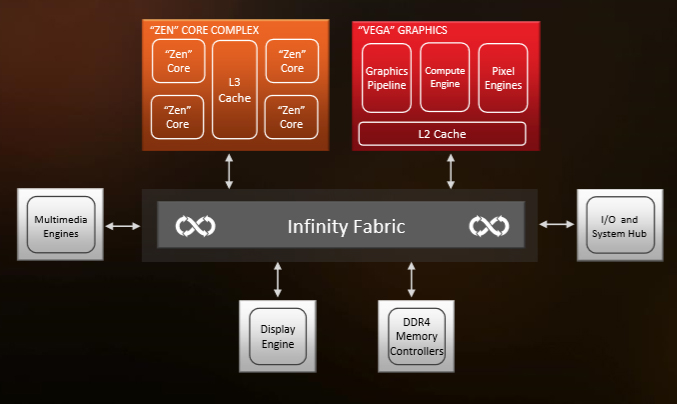
The Raven Ridge APU layout Highlighting the Infinity Fabric Interconnect
We have seen that the Infinity Fabric interconnect used within the SoC benefits from the use of faster memory in our Ryzen APU memory frequency scaling testing - because the Infinity Fabric and memory speed are directly linked, the CPU cores and GPU cores can communicate between the different areas faster. When overclocking a system for more performance, it all comes down to identifying the bottlenecks. Multiple bottlenecks can be in play at once, such as CPU frequency, GPU frequency, memory speed, and interconnect speed. As our set of articles on APU scaling have progressed, the final one left to analyze was GPU frequency. Hence, this review.
Scaling the APU, One Step (50 MHz) at a Time
For our overall analysis, we are splitting the data into two sets.
First up is the performance difference when simply overclocking the integrated graphics. Stepping up the frequency, as shown on the previous pages, usually increases performance, but here we will tell you how much in all four key areas: 2400G frames per second and percentile results, as well as 2200G frames per second and percentile results.
The second is to compare maximums. We have data now with the maximum tested integrated graphics frequency (1600 MHz) and the maximum tested CPU core frequency (3.9 GHz). The question becomes how much of a difference does overclocking one over the other make for gaming. The answer would normally sound obvious, but this is something we want to quantify. If a gamer has a choice between overclocking the CPU or the GPU, what should the target be, and how much should they expect? This data answers that question.
Group 1: 1600 MHz vs Stock
When comparing the results with the Ryzen 2000 series APUs at their stock settings against an overclock of 1600 MHz yields some good results across the majority of the titles tested in our testing suite.
Starting with the average frame rates, the Ryzen 3 2200G showed the biggest gains across the board, with the biggest benefits of overclocking in more graphically intensive games such as Total War: Warhammer 2 and Rise of the Tomb Raider. The 2400G, with its 28% overclock, pushed above 10% in Warhammer 2 and F1 2017, looks like it did not gain as much as the 2200G, but this is due to the lower percentage gain over the stock performance.
Focusing specifically on the 99th percentiles from the testing, the results given were erratic to say the least. All test results were repeatable across operating system reinstalls, but the 2400G showed regression in Shadow of Mordor and Warhammer 2. By contrast, the 2200G saw gains in both of those titles, a minimum of 8% across the board, and several titles scored around a 30% gain. For a 45% overclock, this is pretty good.
Group 2: What is Better, CPU OC or IGP OC?
In this set of results, we compare the uplift gained from a full GPU overclock to a full CPU overclock. This is to show which component of the chip provides the biggest benefit to frame rate performance in games: CPU or graphics. While increasing the CPU frequency is beneficial in improving performance in computationally dependent tasks such as video encoding, rendering and compression tasks, games should enjoy the graphics much more.
In our 2400G results, the winner between the two is clearly the integrated graphics. The CPU data shuffles around the same frame rates, not offering much benefit, while overclocking the GPU gives at least 5% extra frame rates across the board.
As the 2200G starts off from such a low point, overclocking both the CPU and GPU gets extra performance in almost every title. However, only overclocking the integrated graphics gets a good 10% gain across the board as a minimum, but more like 24%+ on games like F1 2017, Rise of the Tomb Raider, and Warhammer 2.
So while the analysis here is perhaps not as long-winded as our memory scaling and core frequency scaling pieces, the crux is that the integrated graphics is the key factor in gaming performance and despite the Infinity Fabric Interconnect combined with faster memory displaying a positive showing in our Ryzen 2000 series memory scaling analysis, the integrated graphics does offer more from a gamers standpoint. Of course, combining faster memory on top of an already overclocked Ryzen 2000 series iGPU is going to be the golden crown.
The Ryzen APUs; iGPU vs Core Frequency Plus Memory Frequency
When we took a look at how CPU Core Frequency Scaling with the Ryzen 5 2400G and Ryzen 3 2200G, we saw that the majority of the benefits came in compute heavy related tasks, and even gaining a distinct advantage when gaming with a discrete GPU. The gaming performance by just overclocking the CPU core frequency didn’t yield the results expected when using integrated graphics. In our dive into Memory Scaling on Zen and Vega, the consensus was that memory has a much greater effect on gaming performance than CPU frequency, as well as memory reliant applications and programs. Now while the focus has been purely on gaming this time around, which is to be expected given the target market AMD has aimed the Ryzen APUs firmly at, the results in some cases made a large difference in average frame rates; 99th percentiles on the whole did improve as the integrated graphics frequency went up, but some of the results were a little erratic, sometimes surpassing the overclock percentage jump.
For gaming, the extra performance gained in relation to the increase in graphics frequency is absolutely paramount in situations where average frame rate sits just below a key metric such as 720p60 or 1080p30. Gaming at 1080p60 is a little too much of a stretch for the integrated Vega cores, unless the game engine is less complex such as with titles such as MOBAs like DOTA 2, League of Legends and more recently, games like Fortnite being fine for this mixture of resolution and frame rate. As we found out in our Ryzen APU Overclocking Guide and Results article, the Ryzen APUs tend to prefer either high CPU frequencies or higher integrated graphics frequencies, but not both at the same time.
This means that users can choose which element of performance they want to improve, if the system is for compute related tasks or gaming. For any compute related workloads, the integrated graphics frequency is ineffective whereas pure MHz on the Ryzen cores and memory frequency can play a major part in improving performance throughput.
| Recommended Reading on AMD Ryzen APUs | |||
| 2400G Review | 2200G Review | Overclocking | Delidding |
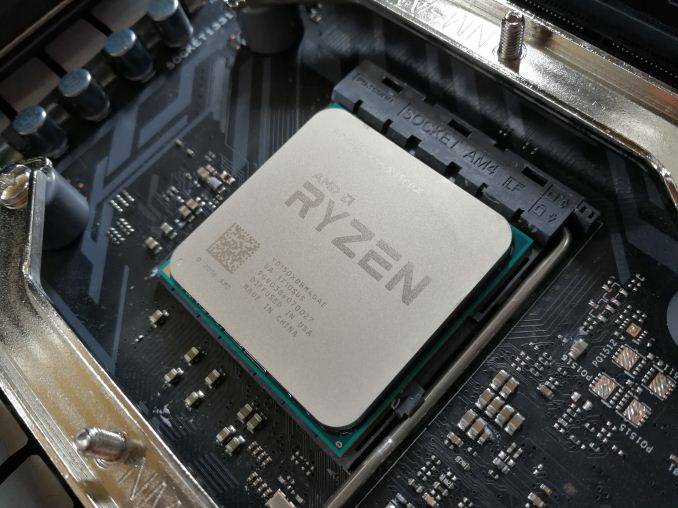 |
 |
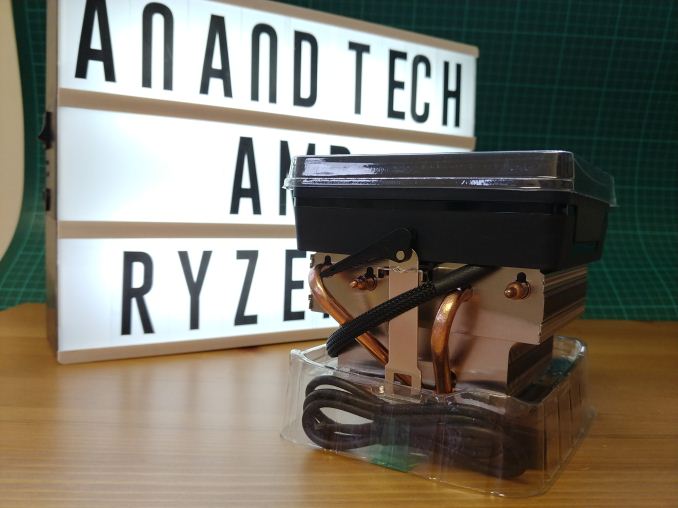 |
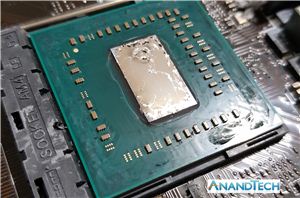 |
| Core Scaling | Memory Scaling | Graphics Scaling | Best CPUs |
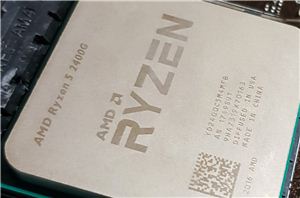 |
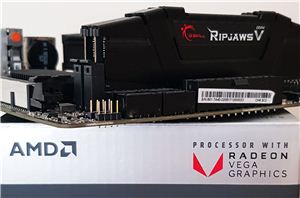 |
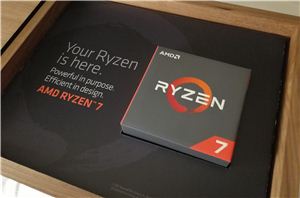 |
|


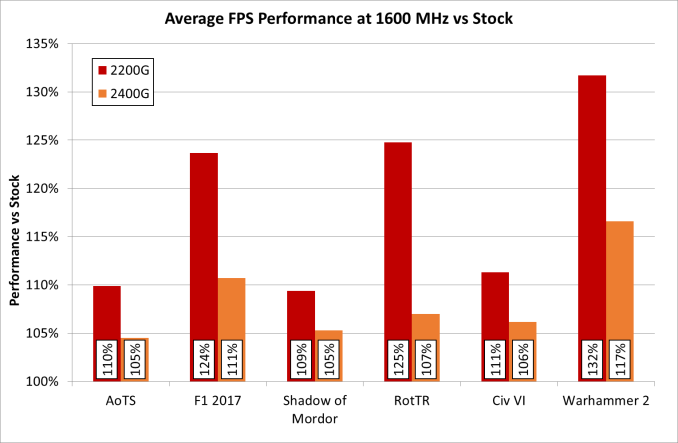
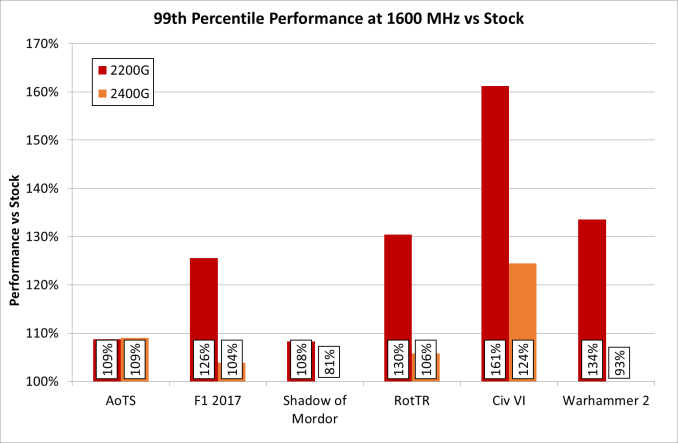
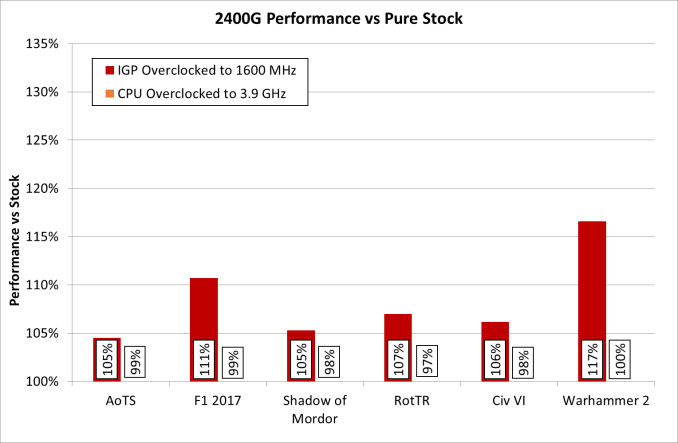
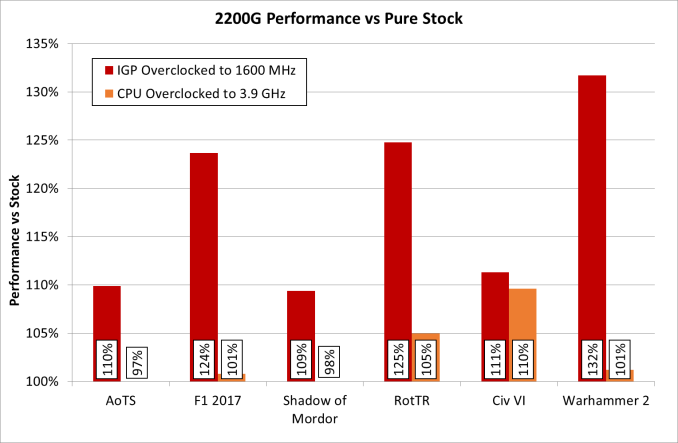
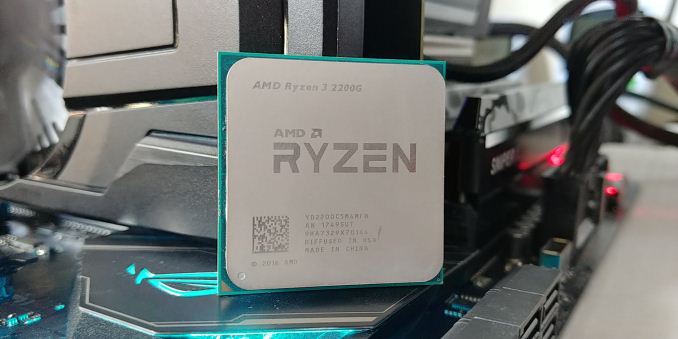








49 Comments
View All Comments
msroadkill612 - Sunday, September 30, 2018 - link
Sorry to be a dick Gavin, but...oignant
ˈpɔɪnjənt/Submit
adjective
evoking a keen sense of sadness or regret.
"a poignant reminder of the passing of time"
synonyms: touching, moving, sad, saddening, affecting, pitiful, piteous, pitiable, pathetic, sorrowful, mournful, tearful, wretched, miserable, bitter, painful, distressing, disturbing, heart-rending, heartbreaking, tear-jerking, plaintive, upsetting, tragic
"the father of the murder victim bade a poignant farewell to his son"
Its a sore point. I misused it similarly in a speech.
msroadkill612 - Sunday, September 30, 2018 - link
Good effort, but a shame temps not included.There is a suspicious pattern here.
On the 2400g at voltage bumped, 1600 gpu clock, it gets good results ... mostly. Its min frames are erratic and even lowered at times.
This could well be heat.
My take home, is that the Apu is so cool, its worth decent cooling and a low latency nvme system disk with a direct pci link to the cpu.
The apu seems a hit in the linux world, and that the apu is becoming a kind of default zen/vega platform - a target for some intimate apu driver tweaking.
Its fine wine indeed.
hashish2020 - Tuesday, October 2, 2018 - link
I am having trouble finding it, but was the memory overclocked as well or just the iGPU?piteq - Tuesday, October 2, 2018 - link
I was reluctant to buy any new graphics card because of the sick prices, so I'm keeping my (really) old Radeon HD 6790(-ish GPU, can't remember exactly - GPU-Z states it has Barts core and 1 GB DDR5, clocked at 900/1100 MHz, respectively). And it's paired with Ryzen 5 1600, on Asus Prime B350-Plus board. Do you think switching CPU to Ryzen 2400G would be some upgrade in the GPU area? I'd like to return to WoW and also play some newer, but not demanding titles. (Slightly slower CPU won't be much of an issue for me).neblogai - Wednesday, October 3, 2018 - link
It would be better for you to start looking for a new GPU- prices are getting good. RX570 for $150 would solve your problem better than switching to a 2400G.V900 - Thursday, October 4, 2018 - link
Just buy a used card, or a GT1030/1050.They're available for roughly what the 2400G costs, but will give you a much bigger GPU boost.
mikato - Thursday, October 4, 2018 - link
The video ads are starting to bother me now, darn.msroadkill612 - Wednesday, October 17, 2018 - link
OP. u misuse poignant in ur opening. It has a "sad" connotation.msroadkill612 - Wednesday, October 17, 2018 - link
Heresy, given the curiously zealous loyalty folks have to sata ssd over clearly very superior nvme, but it would not surprise me if the HDD era SATA interface & even greater lag of the chipset the SATA ports run off, added some significant random delays by gaming standards.There is no comparison in; iops, processing overhead and access times.
I am sure I have seen reviews where they don't even state the test rig's SSD details.